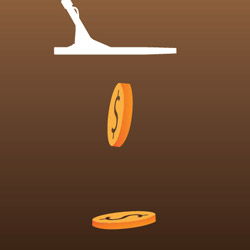In Part 1 of this blog post I explained why ground mineralisation and the conductivity and mass of a target can affect detection depth. Here’s a couple more factors that are less well known.
Surface area
This is not quite so easy to demonstrate, but what you can do, as another experiment, is take those same two cupro-nickle coins you used for the experiment on mass in part one of this blog post and using a hammer make one of them flatter, thinner and consequently larger than the other one by the sheer force of being hammered into a thin sheet of metal. Now bury the non-hammered one at the depth which just stops short of returning an audio signal. Now bury the flattened coin at the same depth and with the same amount of discrimination. What you should find is, the larger surface area of the thinner coin should still respond with an audio response even slightly beyond the depth of the non-hammered coin. We haven’t changed anything about the coins. They are the same with the exception now, that one of them has a greater surface area and is therefore ‘more detectable’!
Angle of the object to the coil
The way that a coin or ring ends up laying in the soil is of great importance. If all coins and rings were lying totally flat in the ground with their “faces” to the coil, then a great deal more would be found than there is at present. The amount of surface area that a detector can read is greatly reduced when an object is turned on its edge (side). Coins buried “on-edge” are far more common than people would believe and some searchers even claim they never found a coin on edge! This might have more to do with their coil sweep speed and discrimination levels, but I digress here.

A horizontal coin (e.g. lying flat) can be detected deeper than a vertical coin (e.g. on edge)
Again, as an experiment, take the ring from your finger and bury it flat (you should see the 'O' shape) at 4” in the ground. Select the all metal mode and scan across the ring. It should respond with a positive signal albeit with a low or weak signal. Now re-bury the ring again, but this time on-edge and scan across the ring. It is very possible that the all metal signal weakened significantly and the only way to ensure you “got the signal” was to considerably slow down the sweep speed with a careful approach of the search coil. However, we don’t normally hunt that slow do we!
Conclusion
So, hopefully this goes some way to help explain why we can at times experience significant depth losses on buried targets in the ground. This can also explain why some coins have been missed at meagre depths of two to three inches. And found years later when returning to a “worked out” site with a new metal detector. This brings me onto the subject of new technology and is a perfect example of just how technological developments can be used to produce more efficient metal detectors which in turn can make lots of fantastic finds even on sites that were considered worked out! But that’s a topic for another day!
Des Dunne




















Comments